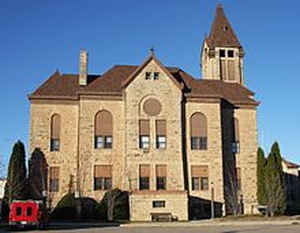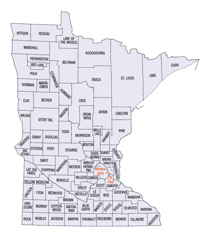Minnesota Counties
There are eighty-seven Counties in Minnesota. On October 27, 1849 nine large Minnesota Counties were created. Among them were Benton, Dahkotah, Itasca, Ramsey, Mahkahta, Pembina, Wabashaw, Washington, and Wahnata. Of those Benton, Dakota, Itasca, Ramsey, Wabasha, and Washington still exist as their original name. With the creation of Kittson County on March 9, 1878, Pembina County no longer existed. When Minnesota was organized as a state, 57 of the present 87 Counties were established. The last county to be created was Lake of the Woods County in 1923Houston County, Minnesota
Houston County Education, Geography, and History
Houston County is a county located in the state of Minnesota. Based on the 2010 census, the population was 19,027. Its county seat is
Caledonia.
Houston County is included in the La Crosse-Onaslaska, WI-MN Metropolitan Statistical Area.
Etymology - Origin of Houston County Name
Named for Samuel Houston, member of Congress from Tennessee, 1823-27; governor of Tennessee, 1827-29; president of Texas, 1836-38, 1841-44; U. S. Senator from Texas, 1845-59; governor of Texas, 1859-61.
Demographics:
County QuickFacts: CensusBureau Quick Facts
Houston County History
Four years before Minnesota was admitted to the Union as the 32nd state on May 11, 1858, Houston County was
chartered after its division from the eastern half of Fillmore County on April 4, 1854. The county seat was the village of Houston for a few
years, but the county board moved the official records to Caledonia for safe storage in the cabin of Commissioner Samuel McPhail. The first
court hearings were held in that cabin, and a one-story courthouse and jail was built in Caledonia in 1857. Turmoil over the county seat
continued, a two-story building was built in Caledonia in 1867, and several referenda allowed Caledonia to prevail as the county seat by 1874.
From that point on, Caledonia prospered, and Houston slowly diminished. The only other area of prominence was La Crescent, which benefited
from its connection to La Crosse, Wisconsin.
The county name was chosen to honor Sam Houston, who was president of Texas before its annexation by the United States and afterward was a
senator from that state. In the years 1854-56, when antagonism between the North and South on slavery questions would lead eventually to the
Civil War, Houston aspired to nomination as the Democratic candidate for the national presidency. In October 1854, the general Democratic
committee of New Hampshire recommended him as "the people's candidate" for the campaign in 1856. His popularity in Minnesota at that time
recommended the name of this county, and, likewise, counties in Tennessee and Texas and cities and villages in Texas, Mississippi, Missouri,
and other states bear his name.
Geography: Land and Water
As reported by the Census Bureau, the county has a total area of 569 square miles (1,470 km2), of which 552 square miles (1,430 km2) is
land and 17 square miles (44 km2) (2.9%) is water.
Among other parts of southeastern Minnesota, the county is in the Driftless Zone, marked by the absence of glacial drift and presence of
bedrock cut by streams into steep hills. The plateau that surrounds Caledonia, the county seat, includes flat, fertile farm land and hilly,
verdant pasture land.
Neighboring Counties
Bordering counties are as follows:
- Winona County, Minnesota (north)
- La Crosse County, Wisconsin (northeast)
- Vernon County, Wisconsin (east)
- Allamakee County, Iowa (south)
- Winneshiek County, Iowa (southwest)
- Fillmore County, Minnesota (west)
Education







